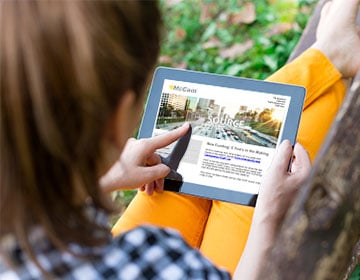Vision Zero: How Can Zero Traffic Fatalities Be Achieved?

Since Vision Zero’s beginning in 1997 in Sweden, more than 30 cities across North America have adopted their own versions of Vision Zero. The program’s long-term goal is simple: to reduce traffic deaths and injuries to zero.
Regardless of progress in road safety and transportation efficiency, traffic fatalities in the United States have climbed to the highest level in twenty years! How is this happening with the effort of making streets safer? There are several factors that contribute to this:
- The presence of smartphones
- Societal pressures leading to unsafe decisions
- Sense of entitlement and impunity on the road
- Driving at excessive speeds and disregarding traffic laws and speed limits
- Inadequate infrastructure and road design
What is Vision Zero?
Vision Zero is a proactive approach to safe mobility that creates safer transportation through system designs, education, enforcement, and technology. It isn’t just a policy or program but a new approach to road safety and eliminating traffic deaths. This initiative emphasizes that the road system should always be safe for all users.
Vision Zero includes multiple stakeholders, including local and national governments, city councils, transportation departments, urban planners, law enforcement, public health organizations, and citizens whose daily actions and decisions on the road are important to its success. This initiative promotes the idea that city streets should be designed to accommodate human error, ensuring the safety of all users. This means that modern transportation should strive to prevent any loss of life or severe injury.
Vision Zero aims to enhance safety in communities. Some strategies for this include:
- Intersection improvements
- Street redesigns
- Legislative changes
- Community engagement
Through the adoption of these and similar measures, communities are actively striving to establish safer streets and save lives using Vision Zero action plans.
 Is Vision Zero Working?
Is Vision Zero Working?
New York City acknowledged the significance of road safety measures when it embraced Vision Zero, leading to substantial enhancements in its road networks. By 2022, NYC saw a significant reduction in road fatalities, validating Vision Zero's efficiency. It began enforcing penalties for speeding violations and began enhancements in infrastructure design and technology. The upgrades in infrastructure included intelligent traffic systems (ITS), adaptive solutions, and speed-regulating traffic controls, all pivotal in increasing pedestrian safety and safer streets.
New York City exemplifies Vision Zero's core principle, which prioritizes the safety of all road users at every intersection. Its commitment acts as a model for other cities and communities contemplating the adoption of Vision Zero.
Hoboken, NJ, serves as another example of Vision Zero's success. The city has accomplished an impressive seven-year period without any traffic fatalities, largely due to measures such as reducing speed limits.
What contributed to Hoboken's remarkable success with its Vision Zero initiative? Attention to road safety came down to a few simple actions and the city's willingness to make the most out of its resources for its city streets. Despite the city's limited budget and resources, these efforts resulted in life-saving outcomes.
Funding for Vision Zero
In an effort to promote change across America, the IIJL has made several grant opportunities available.
Safe Streets and Roads for All (SS4A):
- $1 billion annually for fiscal year 2022-2026
- Planning and Demonstration Grant for SS4A ranges from $100K-$10M
- Implementation Grant for SS4A ranges from $2.5M-$25M.
Strengthening Mobility and Revolutionizing Transportation (SMART):
- $100 million annually for fiscal year 2022-2026
- Large communities: Up to 40%
- Midsized communities: Up to 30%
- Rural communities or regional partnerships: Up to 30%
The year 2024 presents many opportunities, including increased funding for supplementary planning, demonstration activities, and various other initiatives. If you're considering applying for a specific grant program, make sure you check the funding-specific Notice of Funding Opportunity (NOFO) page and prepare to meet all the requirements in the grant proposal.
Our Commitment to Vision Zero
At SWARCO McCain, we are committed to a future where the Vision Zero Initiative and attention to road safety while making streets safer are not just aspirations but standards for our cities and communities.
Our traffic management solutions and intelligent traffic systems (ITS) are crucial in transforming outdated systems into state-of-the-art solutions. Red Light Protect, for instance, addresses some of the most critical road safety challenges we face daily. The great news is that you have the opportunity to integrate our Red Light Protect solution into your city using the SS4A, SMART, and various other Federal Grants accessible until 2026.
Imagine your city placing a strong focus on road safety and working towards achieving zero road fatalities through Vision Zero. It's an effort that your city council and constituents will certainly appreciate.
Reach out to us to learn more about our products and services and how implementing a simple Vision Zero Action plan in your city will transform road safety and eliminate road fatalities.

.png?width=445&height=373&name=MC%20VIDEO-Intro%20%20(3).png)


